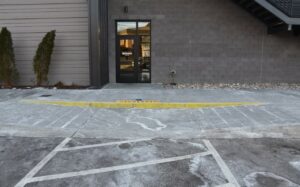
Knott Laboratory provides forensic engineering and animation, Civil & Structural, and Fire & Explosion Investigation services to reconstruct accidents.
Case Spotlight: Ramp Design
Designing ramps to ADA code
Knott Laboratory was recently involved in the investigation of an incident where an individual in a mobility scooter was injured after driving the scooter off the edge of a parallel curb ramp in front of a restaurant. The incident resulted in injuries and subsequent litigation.
We observed that the restaurant had utilized a parallel curb ramp that provided an accessible route from the adjoining Americans with Disabilities Act (ADA) accessible parking spaces. The parallel curb ramp was placed in the middle of the accessible route of the sidewalk as shown below (note that the yellow paint was added after the incident).

The curb ramp did not span the entire width of the accessible route, resulting in an elevation change of 5″ in the accessible route. We determined that the appropriate and reasonable design for the accessible path would have been to utilize a perpendicular curb ramp.
A perpendicular curb ramp utilizes flared edges and eliminates a sudden change in level along the accessible route. In addition, the use of the parallel curb ramp violated the recommendations of numerous design guidelines including the federal ADA design guidelines as well as local design resources for the Authority Having Jurisdiction (AHJ).

As part of our investigation, we utilized a high-definition laser scanner to capture the geometry of the existing accessible route. We then utilized the laser scans to develop engineering drawings that demonstrated the use of a perpendicular curb ramp that would have complied with the federal ADA design guidelines, local design resources for the AHJ, and would have eliminated the change in elevation and prevented the incident.

